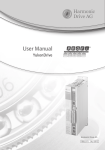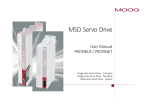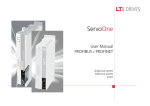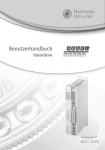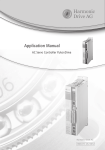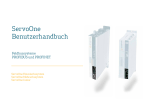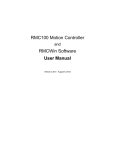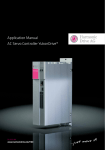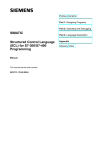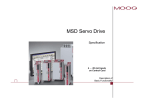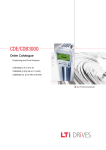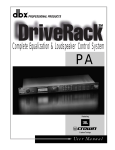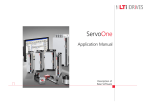Download "user manual"
Transcript
ServoOne User manual The bus modules for ServoOne ! This manual is currently in draft prior to approval and is therefore not yet final and complete. The technical data and the promised characteristics are therefore provisional and may yet change in the course of technical development! ProfiBus ServoOne user manual ID no.: 1100.27B.0-00 Date: 10/2007 We reserve the right to make technical changes. How to use this manual Dear User, This manual is intended for use by project engineers, commissioning engineers and programmers of drives and automation solutions involving the PROFIBUS field bus. It assumes that you have received appropriate training on Profibus and that you have access to relevant reference books. We assume that your drive has already been commissioned – if not, please first refer to the user manual. This manual relates to the ServoOne positioning drive system, referred to below in the abbreviated form “SO”. 1 General 1 2 Commissioning the Profibus interface 2 3 Cyclic data transmission – DPV0 3 4 Cyclic data transmission – DPV1 4 5 Operating modes 5 6 Homing 6 7 Commissioning examples 7 8 PROFIBUS parameters 6 Appendix: Glossary, key words directory 7 PROFIBUS user manual PROFIBUS user manual Pictograms ! Attention! Incorrect operation may damage the drive or cause it to malfunction. Danger from electrical tension! Improper conduct may endanger human life. Danger from rotating parts! The drive may start up automatically. Note: Useful information Table of contents 4 Acyclic data transmission – DPV1....................................................................................... 25 4.1 Examples of request and reply telegrams...................................................................... 30 5 Operating modes................................................................................................................ 33 How to use this manual.............................................................................................................. 3 Pictograms............................................................................................................................... 4 1 General................................................................................................................................... 7 1.1 Measures for your safety................................................................................................. 7 5.1 Speed Control................................................................................................................33 5.2 Speed control circuit and associated control parameters............................................... 34 5.3 Position control..............................................................................................................35 5.4 Position control circuit and associated control parameters..............................................37 1.2 Introduction to PROFIBUS............................................................................................... 7 6 Homing................................................................................................................................. 39 1.3 System requirements....................................................................................................... 8 6.1 Homing movements performed by the drive................................................................. 39 1.4 Further documentation................................................................................................... 8 2 Commissioning the Profibus interface................................................................................ 9 2.1 Connections and user controls ....................................................................................... 9 2.2 Plug configuration for the Profibus cable ....................................................................... 9 2.3 Bus termination . ...........................................................................................................10 6.2 Homing movement speeds............................................................................................ 39 6.3 Homing movement accelerations.................................................................................. 39 6.4 Zeroing offset............................................................................................................... 39 6.5 Homing cams, limit switches......................................................................................... 39 6.6 Homing movement methods......................................................................................... 40 2.4 Setting the drive address . ............................................................................................10 7 Examples of commissioning using manufacturer-specific telegrams..............................41 2.5 Operating displays . .......................................................................................................10 7.1 Position control using PPO 5...........................................................................................41 2.6 GSD file . .......................................................................................................................11 7.2 Conversion of reference values and actual values using factor group parameters...........42 3 Cyclic data transmission – DPV0..........................................................................................13 3.1 Parameter process data objects (PPO).............................................................................13 3.1.1 Standard telegrams for “PROFIdrive”...................................................................13 3.1.2 User-specific PPO.................................................................................................15 3.1.3 Parameter channel PKW.......................................................................................17 7.3 Examples for setting the user factor group.................................................................... 44 7.4 Speed control using PPO 2............................................................................................ 44 7.4.1 Speed settings.................................................................................................... 46 7.5 Mappable parameters................................................................................................... 46 8 Profibus parameters.............................................................................................................47 3.2 Master control word.......................................................................................................19 3.3 Drive status word...........................................................................................................21 3.4 Drive status machine..................................................................................................... 22 Appendix – glossary.................................................................................................................. 49 Index............................................................................................................................................51 PROFIBUS user manual PROFIBUS user manual 1 General 1.2 Introduction to PROFIBUS The Profibus implementation in ServoOne is based on the PROFIdrive profile “Profibus PROFdrive profile version 4.0” dated August 2005. 1.1 Measures for your Safety Drive controllers of the ServoOne family are quick and easy to handle. For your own safety and for the safe functioning of your device, please be sure to observe the following points: Read the Operating Manual first! 1. • Follow the safety instructions! Performance features in key words – Data transmission using two-wire twisted pair cable (RS 485) – Transmission rate: optionally 9.6 K, 19.2 K, 45.45 K, 93.75 K, 187.5 K, 500 K, 1.5 M, 3 M, 6 M or 12 MBaud – Automatic Baud rate detection – Profibus address can be set using the rotary coding switches or alternatively using the addressing parameters – Cyclic data exchange reference and actual values using DPV0 – Acyclic data exchange using DPV1 Electric drives are subject to certain hazards: • Electric voltages > 230 V/460 V: Dangerously high voltages may still be present 10 minutes after the power is switched off. so always make sure the system is no longer live! • Rotating parts • Hot surfaces – Synchronisation of all connected drives using freeze mode and sync mode – Reading and writing drive parameters using the PKW channel or DPV1 Your qualification: • In order to prevent personal injury or damage to property, only personnel with electrical engineering qualifications may work on the device. • Knowledge of the national accident prevention regulations (such as VBG4 in Germany) • Knowledge of structure and networking using the CAN field bus U V N U V N L+ RB L- L+ RB L- L3 L2 L1 L3 L2 L1 During installation observe the following instructions: • Always comply with the connection conditions and technical specifications. • Standards for electrical installation, e.g. cable cross-sections, screening etc. • Do not touch electronic components and contacts (electrostatic discharge may destroy components). PROFIBUS user manual [ General ] PROFIBUS user manual 1.3 System requirements It is assumed that you have access to a standard PROFIBUS set-up program or a PROFIBUS interface driver. 1.4 Further documentation • User manual for commissioning the drive device • User manual for further parameterisation to customise the application. The user manual can be downloaded as a PDF file from the “Service” area on our Homepage http://www.lust-tec.de. • CiA DS-301 (Rev. 4.0): Application Layer and Communication Profile • CiA DSP-402 (Rev. 2.0): Device Profile Drives and Motion Control 2 Commissioning the Profibus interface 2.2 Plug configuration for the Profibus cable The Profibus is connected using a nine-pin sub-D plug. The pin assignment is shown in Fig. 2-2 and described in Table 2.1. RxD TxD-P 1 2 3 DGND 4 5 2.1 Connections and User controls The connections and user controls for the Profibus interface are shown schematically in Figure 2-1. The LEDs H1, H2, H3 act as status indicators. The rotary coding switches S1 and S2 can be used to set the Profibus address for the drive. The Profibus cable is connected to the plug X14. X14 6 VP 5 Volt 7 8 9 RxD TxD-N Figure Pin assignment of sub-D plug connector Front plate No. Comments H1 LED for status indication (yellow) H2 LED for status indication (red) H3 LED for status indication (green) S1 Rotary coding switch for setting the Profibus address for the drive = 0x(S2)(S1) S2 Rotary coding switch for setting the Profibus address for the drive = 0x(S2)(S1) X14 Profibus cable connection PIN Signal Description 1 SHIELD Earthed shield 2 RP Reserved for power supply via the bus RxD / TxD-P Send and receive data (+) CNTR-P Control signal for repeater (+) DGND Data reference potential and power supply to terminating resistor (-) 6 VP Power supply for terminating resistor (+) 7 RP Reserved for power supply via the bus RxD / TxD-N Send and receive data (-) CNTR-N Control signal for repeater (-) 3 B/B’ (red) 4 5 8 9 Figure Profibus options card RS-485 C/C’ A/A’ (green) Table Description of pin assignment The pin assignments shown with dark backgrounds in the table are not necessary from the user’s point of view. The control signals used for the repeaters are optional, and the power supply for the terminating resistors is provided by the device. PROFIBUS user manual [ Commissioning ] PROFIBUS user manual 2.3 Bus termination If the drive controller is initially at the end of the bus system, a plug with an integral terminating resistor Rt should be used. In addition to the cable terminating resistor in accordance with the EIA-RS-485 standard, a pull-down resistor Rd against the data reference potential DGND and a pull-up resistor Ru against VP are provided. This ensures a defined no-load potential of 1.1 Volt between pins 3 and 8. In a made-up Profibus cable these resistors are all incorporated as standard in the Profibus plug and the terminating resistor can be activated using a switch on the Profibus plug. The following figure shows a Sub-D 9-pin plug bus termination. Vp = 5 Volt (6) Ru = 390 Ohm RxD TxD-P (3) 10 The drive address can also be assigned using parameter 918 (COM_DP_Address). For this purpose the rotary coding switches must be set to value in excess of 125. The drive address set by software address is not loaded until a 24 Volt reset has been applied to the device. 2.5 Operating displays Options module: Three LEDs are mounted on the options card; these give indications regarding the current operating status of the module. In Tables 2-2 and 2-3 the operating statuses of the Profibus module are listed, based on the various LED illumination combinations. LED 1, green LED 2, red B (red) Status Reset (after switching on) Rt = 220 Ohm ASIC RAM test and initialisation A (green) RxD TxD-N (8) End of ASIC RAM test and initialisation Rd = 390 Ohm Table Self-test during diagnostics GND (6) Device Plug Profibus cable Fig. Sub-D 9-pin plug bus termination LED 1, green LED 2, red Status Seeking Baud rate after switching on without bus connection Seeking Baud rate after the bus connection has already been established 2.4 Setting the drive address The drive address can be set as standard using the rotary coding switches on the options card (see Fig. 2-1). The address range runs from 0 to 125. The drive address is not loaded until a 24 Volt reset has been applied to the device Awaiting parameterisation data Communication: Data exchange without acyclic master class 2 connection. Yellow LED lights up. LED 1, green LED 2, red Status Communication: Data exchange “clear state” Incorrect parameterisation data Incorrect configuration data Communication: Data exchange with acyclic master class 2 connection. Table Operation diagnostics LED 3, yellow Status Device is exchanging data Table Data exchange 2.6 GSD file The device master data file contains the summary of the device features in a standardised form. The device features include for instance the device name, the bus timing, the extended services available and the modules that can be selected (telegram types). In order to use different telegram types, the GSD file must be linked in at the configuration phase of the Profibus network. This file contains, as well as the standard “Profidrive Profile” telegrams, additional manufacturer-specific telegram types. PROFIBUS user manual [ Commissioning ] 11 PROFIBUS user manual 12 3 Cyclic data transmission – DPV0 3.1 Parameter process data objects (PPO) The establishment of communications between a class 1 master and the ServoOne drive controller is essentially performed in three phases. Firstly the ServoOne is parameterised with the current bus parameters, monitoring times and drive-specific parameters (phase 1). In the configuration phase a configuration sent by the master is compared with the actual ServoOne configuration (phase 2). Once these two phases have been completed successfully, the cyclic user data traffic starts (phase 3). The various telegram types (Parameter Process Data Objects - PPO) are prepared in the GSD file. These PPOs form the basis of the configuration phase. The project engineer knows from the GSD file how many bytes are required for the input and output data for Profibus communication between the master and the drive controller and can use this information to perform his settings in the configuration tool. As well as the standard telegrams in accordance with the “PROFIdrive – Profile”, there are additional userspecific telegram types. In addition to the PZD process data channel, the user-specific telegram make partial use of a PKW parameter channel. Abbreviation The table below lists firstly the standard “Profidrive” telegrams that are supported by the drive controller. Table 3-1 explains the abbreviations used to assign standard telegrams to a specific process data channel. The process data channel (abbreviated to PZD) is grouped by words. Control word 1 1 STW2 Control word 2 1 ZSW1 Status word 1 1 ZSW2 Status word 2 1 NSOLL_A Speed reference 1 NIST_A Actual speed 1 SATZANW Set selection (from the driving set table) 1 AKTSATZ Current set selection (from the driving set table) 1 XSOLL_A Reference position 2 XIST_A Actual position 2 TARPOS_A Reference destination position 2 VELOCITY_A Reference speed 2 Table Abbreviations Standard telegram 1 is a defined telegram type for speed control. It consists of two input words and two output words as shown in the following table. PZD number PZD number Actual values 1 2 STW1 NSOLL_A 1 2 ZSW1 NIST_A Table Standard telegram 1 PROFIBUS user manual [ DPV0 ] Number of words STW1 Reference values 3.1.1 Standard “PROFIdrive” telegrams Name 13 14 PROFIBUS user manual Standard telegram 7 is a defined telegram type for driving set selection. There are a total of 16 driving sets available for selection in the drive. This telegram type consists of two input words and two output words as shown in the following table. Standard telegram 9 is a defined telegram type for positioning. It consists of six input words and five output words as shown in the following table. PZD number PZD number Reference values 1 2 STW1 SATZANW Reference values 1 STW1 PZD number PZD number Actual values 1 2 ZSW1 AKTSATZ Actual values 2 1 3 4 5 TARPOS_A STW2 XIST_A ZSW2 6 VELOCITY_A 2 ZSW1 NIST_A Table Standard telegram 9 Table Standard telegram 7 Standard telegram 8 is a defined telegram type for positioning with the facility for specifying a positioning speed. It consists of five input words and five output words as shown in the following table. PZD number Reference values PZD number Actual values 1 2 STW1 1 ZSW1 Table Standard telegram 8 3 XSOLL_A 4 5 STW2 NSOLL_A 2 XIST_A ZSW2 NIST_A Every standard telegram in the device is described in the GSD file by a PROFIdrive Profile configuration identifier (ID). The following table shows these identifiers for the selected standard telegrams. Telegram type Data area Identifier (ID) Standard telegram 1 2 output words and 2 input words 0xC3 0xC1 0xC1 0xFD 0x00 0x01 Standard telegram 7 2 output words and 2 input words 0xC3 0xC1 0xC1 0xFD 0x00 0x07 Standard telegram 8 5 output words and 5 input words 0xC3 0xC4 0xC4 0xFD 0x00 0x08 Standard telegram 9 6 output words and 5 input words 0xC3 0xC5 0xC4 0xFD 0x00 0x09 Table Identifiers 3.1.2 User-specific PPOs As well as the standard telegrams that are supported there are in addition further userspecific PPOs (Parameter Process data Objects). The following PPOs are also transmitted cyclically and in addition to the PZD process data channel partially contain a PKW para meter channel, thereby allowing access to the drive parameter values. PPO PKW PZD 1 PKE IND PKW 1 PKW 2 STW/ ZSW REFERENCE VALUE/ actual value - - - - - - - - 2 PKE IND PKW 1 PKW 2 STW/ ZSW REFERENCE VALUE/ actual value PZD 3 PZD 4 PZD 5 PZD 6 - - - - 3* - - - - STW/ ZSW REFERENCE VALUE/ actual value - - - - - - - - 4 - - - - STW/ ZSW REFERENCE VALUE/ actual value PZD 3 PZD 4 PZD 5 PZD 6 - - - - 5 PKE IND PKW 1 PKW 2 STW/ ZSW REFERENCE VALUE/ actual value PZD 3 PZD 4 PZD 5 PZD 6 PZD 7 PZD 8 PZD 9 PZD 10 - - - - STW/ ZSW REFERENCE VALUE/ actual value PZD 3 PZD 4 - - - - - - PKE IND PKW 1 PKW 2 STW/ ZSW REFERENCE VALUE/ actual value PZD 3 PZD 4 - - - - - - - - - - STW/ ZSW REFERENCE VALUE/ actual value PZD 3 PZD 4 PZD 5 PZD 6 PZD 7 PZD 8 - - PKE IND PKW 1 PKW 2 STW/ ZSW REFERENCE VALUE/ actual value PZD 3 PZD 4 PZD 5 PZD 6 PZD 7 PZD 8 - - - - - - STW/ ZSW REFERENCE VALUE/ actual value PZD 3 PZD 4 PZD 5 PZD 6 PZD 7 PZD 8 PZD 9 PZD 10 (*) PPO3 is the standard telegram 1 Table User-specific Parameter Process data Objects PROFIBUS user manual [ DPV0 ] 15 PROFIBUS user manual In the drive parameter list there exist two signal tables, which contain all the process data that can be cyclically read and written for the Profibus communications DPV0. All possible process data signals that can be written can be found in the signal table 1284 (COM_DP_SignalList_Write) and all possible process data signals that can be read can be found in the signal table 1285 (COM_DP_SignalList_Read). The most important parameters that can be read and written are also documented in Chapter 6. 16 Length of the data 00 = 1 byte/word 15 = 16 bytes/words The process data signals that can be written can be configured in the signal table 915 (COM_DP_PZDSelectionWrite). The number of process data available to be written are determined by the PPO type that is selected. Input/Output 00 = specific identification format 01 = input 10 = output 11 = input/output 0 = byte, 1 = word The process data signals that can be read can be configured in the signal table 916 (COM_DP_PZDSelectionRead). The number of process data available to be read are also determined by the PPO type that is selected. When using standard telegrams the process data signals in the signal tables are automatically configured by the firmware. The user-specific drive telegram types are described by a configuration identifier (ID) in the GSD file. This describes the structure of the cyclic report data using a special identification format shown in the figure below. 0 = consistency over byte/word 1 = consistency over the overall length Figure Identification format (identifier) After the parameterisation phase, the master sends the drive a configuration telegram containing this special identification (ID). On receipt of this, the drive compares the data in the configuration telegram with the configuration held in the drive. The identifier determined by the PPO type can be found in the GSD file under the heading “Modules”. The following table shows these identifiers for the user-specific telegrams. PPO type Identifier(ID) hex Identifier(ID) bin Evaluation using the special identification format (Figure 3.6) Reference toTable AK slave-master 1 0xF3 0xF1 1111 0011 1111 0001 4 words input/output data (consistent overall length)2 words input/output data (consistent overall length) PKW channel PZD channel 2 0xF3 0xF5 1111 0011 1111 0101 4 words input/output data (consistent overall length)6 words input/output data (consistent overall length) PKW channel PZD channel 3 0xF1 1111 0001 2 words input/output data (consistent overall length) PZD channel 4 0xF5 1111 0101 6 words input/output data (consistent overall length) PZD channel 5 0xF3 0xF9 1111 0011 1111 1001 4 words input/output data (consistent overall length)10 words input/ output data (consistent overall length) PKW channel PZD channel 0xF3 1111 0011 4 words input/output data (consistent overall length) PZD channel 0xF3 0xF3 1111 0011 1111 0011 4 words input/output data (consistent overall length)4 words input/output data (consistent overall length) PKW channel PZD channel 0xF7 1111 0111 8 words input/output data (consistent overall length) PZD channel 0xF3 0xF7 1111 0111 1111 0111 4 words input/output data (consistent overall length)8 words input/output data (consistent overall length) PKW channel PZD channel 0xF9 1111 1001 10 words input/output data (consistent overall length) PZD channel Table Listing of identifiers 3.1.3 PKW parameter channel Some PPOs offer an additional cyclic parameter channel. This channel allows drive parameters to the read and written. PKW 1st byte 2nd byte PKE (1 word) 3rd byte 4th byte IND (1 word) 5th byte 6th byte PKW1 (1 word) 7th byte 8th byte PKW2 (1 word) Table Structure of the PKW channel PROFIBUS user manual [ DPV0 ] 17 PROFIBUS user manual The parameter consists of a total of 4 words: the parameter identifier PKE (1 word), the sub-index IND (1 word) and the parameter identification word, which occupies the data area PKW1 (1 word) to PKW2 (1 word). The parameter identification is shown by bits in the following table. AK 15 14 PNU 13 12 11 10 9 8 7 6 5 4 3 2 1 0 Reply identification Function 0 No reply 1 Parameter value sent (word) 2 Parameter value sent (double word) 3 Parameter description sent 4 Parameter value (array) sent (word) 5 Parameter value (array) sent (double word) AK Request or reply identification (value range 0..15) 6 – PNU Parameter number (value range 1…4095) 7 Request not executable, see error no. Table Reply identification AK (slave ð master) Table PKE parameter identification The following tables list the request identification (master) and the reply identification (slave). Request identification Function On reply recognition 7 the error number sent to the drive from the master is shown in the area PKW1 to PKW2. The following table lists these error numbers. Error no. Statement 0 Impermissible PNU 1 Parameter cannot be changed 2 Lower or upper parameter value limit transgressed 3 Defective sub-index 4 Not an array 5 Incorrect data type 0 No request 1 Request parameter value 2 Change parameter value (word) 3 Change parameter value (double word) 4 Read parameter description 5 - 6 Request parameter value (array) 7 Change parameter value (array) (word) 17 Request cannot be executed because of the operating status 8 Change parameter value (array) (double word) 18 Other error Table Request identification AK (master ð slave) 18 ... Table Error numbers In addition request identification 4 can be used to read a parameter description. The parameter description receives relevant information regarding the respective parameter. The following table shows the sub-indexes that can be used to access the individual parameter structure elements. The sub-index is indicated only by byte 3. Sub-index Meaning Identifier (ID) V2 2 Number of field elements or string length Unsigned 16 3 Standardisation factor Floating point 4 Variable attributes Octet string 2 5 Reserved Octet string 4 6 Name (only the first four bytes are sent) Visible string 16 7 Lower limit value Octet string 4 8 Upper limit value Octet string 4 9 Reserved Octet string 2 10 ID extension Extension V2 11 PZD reference parameter Unsigned 16 12 PZD standardisation V2 The identifier (sub-index 1) in the parameter description identifies additional characteristics of the respective parameter. Table 3-8 describes the meaning of the identifier. Meaning Reserved 14 Array Explanation Parameter value can only be reset If this bit is set, the respective parameter value can be varied externally only so as to be set to zero 12 Parameter value was changed to a value different from the factory settings If this bit is set, the parameter value is different from the factory settings 11 Reserved 10 Additional text array can be called up 9 Parameter cannot be written 8 Standardisation factor and variable attributes not relevant 0-7 This bit is set if the parameter is of a data type that cannot be used to calculate any physical values (e.g. data type string) Data type of the parameter value (value = “Profi-Drive table 9”) Table Structure of the identifier 3.2 Master control word Table Parameter description 15 Meaning 13 Data type 1 Bit Bit Explanation Operating mode: Speed Control Operating mode: Positioning control Bit 15 (MSB) Not used Bit 14 Not used Bit 13 0 Not used New reference values activated by toggling the master control word bit 6a 1 Not used New reference values are loaded directly PROFIBUS user manual [ DPV0 ] 19 PROFIBUS user manual Operating mode: Speed Control Operating mode: Positioning control Bit 12 Operating mode: Speed Control Operating mode: Positioning control Bit 4 0 Not used Positioning reference value = absolute 0 Reset ramp generator Interrupt positioning set 1 Not used Positioning reference value = relative 1 Activate ramp generator Do not interrupt positioning set Bit 11 Bit 3 0 Not used Stop homing run 0 Controller not enabled 1 Not used Start homing run 1 Controller enabled (operation enabled) Bit 10 Bit 2 0 No access rights over the PLC 0 Quick stop active 1 Access rights over the PLC 1 Quick stop inactive Bit 9 Bit 1 0 Not used 0 Spin out of true active 1 Not used 1 Spin out of true inactive Bit 8 Bit 0 0 Not used 0 Switch off power stage (OFF) 1 Not used 1 Switch on power stage (ON) Table Master control word Bit 7 0 1 20 Meaning Error acknowledgement at rising flank 0 ð 1 Bit 6 0 Deactivate reference value 1 Activate reference value Activate positioning set at rising and falling flank (0 ð 1 and 1 ð 0) 0 Freeze ramp generator No feed hold 1 Unfreeze ramp generator Feed hold Bit 5 Bit 0 - 11 Not used Bit 12 - 15 Master sign of life Table Master control word 2 If no synchronous application is implemented, the master sign of life need not be transmitted, allowing the entire second status word to be freely assigned. 3.3 Drive status word Operating mode: Speed Control Bit 15 (MSB) Operating mode: Positioning control 1 Operating mode: Speed Control Operating mode: Positioning control Speed error within the tolerance band Positioning slippage error within the tolerance band Bit 7 Not used Bit 14 0 „ENPO“ or „Safe Standstill“ not set 1 „ENPO“ or „Safe Standstill“ set Bit 13 0 Drive rotating 1 Drive stationary 0 No warning 1 Warning registered Bit 6 0 Switch on not prevented 1 Switch on prevented Bit 5 Bit 12 0 Not used 1 Not used Motion request confirmation by toggling this bit 0 Not used Homing point not yet set 1 Not used Homing point set 0 Frequency or speed not reached Target position not reached 1 Frequency or speed reached or exceeded Target position reached Bit 11 Bit 10 Bit 9 0 Quick stop activated 1 Quick stop deactivated Bit 4 0 Spin out of true activated 1 Spin out of true deactivated Bit 3 0 No error 1 Error reported Bit 2 0 Control blocked 1 Control active (in operation / drive responding to reference values) 0 No access rights over the PLC Bit 1 1 Access rights over the PLC granted 0 Power stage inactive (not ready) 1 Power stage active (ready) Bit 8 0 Speed error outside the tolerance band Positioning slippage error outside the tolerance band Bit 0 PROFIBUS user manual [ DPV0 ] 21 PROFIBUS user manual Operating mode: Speed Control Operating mode: Positioning control 0 Not ready to start 1 Ready to start 3.4 Drive status machine to perform changes to the control word, STW bit 10 must be set from system status 2 the Safe Standstill must first be set and then a posltive flank of the ENPO occur ”Quick stop active” System status 6 Table Drive status word Bit 0-1 Meaning Profile generator status 0: Halt 1: Acceleration 2: Positioning with allowable speed 3: Delay 2 Torque limitation with positive direction of travel 3 Torque limitation with negative direction of travel 4 ISD00 5 ISD01 6 ISD02 7 ISD03 8 Reserved 9 Reserved 10 Reserved 11 Reserved 12-15 (9) Quick stop activated Reserved for Profidrive Table Master control word 2 (10) Quick stop deactivated “Control active“ System status 5 (4) Controller enabled Error (5) Controller blocked “Switched on“ System status 4 (6) Power stage blocked (13) Error “Error response active” System status 7 (12) Standstill detected (11) Spin out of true activated (3) Power stage switched on (7) Spin out of true or quick stop activated Hardware enable blocked (16) Hardware enable blocked (6) Power stage blocked “Ready to switch on” System status 3 (2) Quick stop and spin out of true deactivated “Error” System status 8 (7) Quick stop or spin out of true activated “Switch on blocked” System status 2 (1) UZK OK (15) Error acknowledgement (8) UZK too low “Not ready to switch on”System status 1 If no synchronous application is implemented, the slave sign of life need not be transmitted, allowing the entire second status word to be freely assigned. (14) Error response ended (0) Start “System initialisation running” System status 0 Figure GeneralSystem status machine (control via Profibus) 22 System status Designation Description 0 System initialisation running (start) Initialisation after device reset (e.g. hardware, parameter list, controller, …) 1 Not ready to switch on Initialisation completed, but no power supply, or intermediate circuit voltage less than switchon threshold 2 Switch-on inhibit(switch on disabled) Intermediate circuit voltage greater than switch-on threshold 3 Ready to switch on Optional conditions satisfied (e.g. homing run, quick stop inactive …) 4 Switched on Power stage enabled 5 Operation enabled Power supplied to motor, operation active 6 Quick stop active Quick stop active* 7 Fault reaction active Fault reaction is active, reference values from the Profibus master are ignored. 8 Fault Drive in fault condition, reference values from the Profibus master are ignored. * Quick stop can be triggered by various circumstances. The parameter 2218 (MP_QuickStopOC) allows the type of quick stop to be selected. Table System statuses Quickstop option code Meaning Quickstop option code 8 Meaning Slow down on the voltage limit and stay in QUICK STOP Table Quick Stop Option Code System status changeover Designation Description 0 Start Initialisation after boot-up completed 1 UZK OK Intermediate circuit voltage greater than switch-on threshold 2 Quick stop and spin out of true deactivated Spin out of true deactivated ð STW bit 1 = 1 Quick stop deactivated ð STW bit 2 = 1 3 Power stage switched on Power stage switched on ð STW bit 0 = 1 4 Controller enabled Controller enabled ð STW bit 3 = 1 5 Control blocked Control blocked ð STW Bit 3 = 0 * 6 Power stage blocked Power stage blocked ð STW bit 0 = 0 7 Quick stop or spin out of true activated Spin out of true activated ð STW bit 1 = 0 Quick stop activated ð STW bit 2 = 0 8 UZK too low Intermediate circuit voltage less than switch-on threshold 9 Quick stop activated Activate quick stop ð STW bit 2 = 0 0 Disable drive function 10 Quick stop deactivated Deactivate quick stop ð STW bit 2 = 1 1 Slow down on slow down ramp 11 Spin out of true activated Activate spin out of true ð STW bit 1 = 0 2 Slow down on quick stop ramp 12 Standstill detected Standstill was detected 3 Slow down on the current limit 13 Fault Fault event occurred (can occur in any system status) 4 Slow down on the voltage limit 14 Fault reaction ended Fault reaction has ended (e.g. fault stop ramp) 5 Slow down on slow down ramp and stay in QUICK STOP 6 Slow down on quick stop ramp and stay in QUICK STOP 15 Fault acknowledgement 7 Slow down on the current limit and stay in QUICK STOP Acknowledgement of the reported fault ð STW bit 7 = 1 or by a rising flank of the power stage enable PROFIBUS user manual [ DPV0 ] 23 PROFIBUS user manual System status changeover 16 Designation Power stage blocked Description Power stage blocked (can occur in any system status) * Parameter 144 (Autostart) determines whether the control of the operation enable is flank-triggered (0) or status-dependent (1) [Parameter List ðMotion Profile ðBasic Settings]. Table System status changeovers 24 4 Acyclic data transmission – DPV1 Acyclic services Master class Meaning DSAP SSAP Write request 1 Write request via DPV1 33 33H Interrupt 1 Interrupt handling 33 33H [Interrupts are not currently supported] In addition to DPV0 cyclic data communications, which are intended as standard for quick updates of I/O process data, DPV1 acyclic services are available as one-off events. They offer the facility for instance to read or write parameters acyclically and thus without interfering with cyclic data traffic. Telegram type SD2 in accordance with the following table is used for the DPV1 Profibus DP extension. Table An overview of the acyclic services offered The access mechanism on DPV1 is always performed according to a fixed layout: 1. Write request (5F): SD LE LEr SD DA Start Delimiter Length Length repeat Start Delimiter 68H X X 68H SA DSAP SSAP DU FCS ED Destination Address Source Address Destination Service Access Point Source Service Access Point Data Unit Frame Check Sequence End Delimiter xx xx xx xx X.. xx 16H SD .. DSAP SSAP DU Req. ID DU Slot DU Index DU Length DU User FCS ED 68H xx 32 30 5F 0 2F n+1 0..n xx 16H 2. Write reply (5F): Table Profibus SD2 telegram for DPV1 services The acyclic services can be used equally well by a class 1 master (PLC etc.) and by a class 2 master (PC tool). The following table gives and overview of the acyclic services available in relation to the respective master class. SD .. DSAP SSAP DU Req. ID DU Slot DU Index DU Length FCS ED 68H xx 32 30 5F 0 2F n+1 xx 16H 3. Read request (5E): DSAP SSAP SD .. DSAP SSAP DU Req. ID DU Slot DU Index DU Length FCS ED Establish an acyclic connection 32H 31H 68H xx 32 30 5E 0 2F MAX xx 16H 2 Break off an acyclic connection 32H 0..30H Read request 2 Read request via DPV1 32H 0..30H Write request 2 Write request via DPV1 32H 0..30H Data request 2 Data transfer 32H 0..30H Read request 1 Read request via DPV1 33 33H Acyclic services Master class Initiate request 2 Abort request Meaning 4. Read reply (5E): SD .. DSAP SSAP DU Req. ID DU Slot DU Index DU Length DU User FCS ED 68H xx 32 30 5E 0 2F n+1 0..n Xx 16H PROFIBUS user manual [ DPV1 ] 25 PROFIBUS user manual Each read or write access must first be initiated by a write service on Data Unit Index 47 (2Fhex) (1). This write request gives the slave the information about the request it should execute. After this the slave acknowledges with a reply telegram (2), which initially contains no reply data. This is simply an acknowledgement of the request and contains only the mirrored DPV1 header of the request telegram. In the event of an error, a negative reply is sent. To then read the data from the slave, the master must present a read request (3). If the reply (4) to this is positive, the user data can be used by the master. In the event of an error, a negative reply is sent. Figure “DPV1 Read Request” shows the telegram sequence for a read access. This shows the slave sending a negative read reply to the first read request. This negative read reply means that the required data cannot yet be provided. Not until the following cycle has the slave executed the request to the extent that it can send a positive read reply with the requested data. 26 Word format: 0th byte High byte 1st byte Low byte Double word format 0th byte High byte High word 1st byte Low byte High word 2nd byte High byte Low word 3rd byte Low byte Low word The data unit in the table “Profibus SD2 telegram for DPV1 services” of telegram type SD2 can be split into five areas: • Req.id (1 byte) This is the function number of the DPV1 service. This describes for instance whether a parameter should be read or should be written. More detailed information can be found in the table “Assignment of the Data Unit”. • Slot (1 byte) DPV1 slaves consist of a number of physical or virtual slots. The drive is triggered by addressing a slot, following which the slot address is not evaluated. Figure DPV1 Read Request This transmission format is in “Big Endian” (Motorola, the highest byte is transmitted first). • Index (1 byte) The index contains the address of the data area in which the slave makes available the data for a parameter access. In accordance with ProfiDrive this is specified with the fixed data area number 47. • Length (1 byte) Gives the length of the user data that follow. In the case of a read access, the length must be sufficiently large for the data to be read (max. 240 byte) • • User (1 byte…n byte) Contains the user data to be processed Data Unit (DU) Byte Data Unit Param Value 2 Index 2FH 3 Length xx Length of the user data (max 240 bytes) 4..n User data xx User data Meaning Index [Interrupts are not currently supported] Table Assignment of the Data Unit Data Unit (DU) Byte Data Unit Param Value 0 Requ. ID 48H Idle REQ, RES Idle ANF, ANTW 51H Data transport REQ, RES Data transport ANF, ANTW 56H Resource manager, REQ Resource manager ANF 57H Initiate REQ, RES Initiate ANF, ANTW 58H Abort REQ Abort ANF 5CH Interrupt REQ, RES Interrupt ANF, ANTW 5EH Read REQ, RES Read ANF, ANTW 5FH Write REQ, RES Write ANF, ANTW D1H Data transport NEG RES Data transport ANTW D7H Initiate NEG RES Initiate negative ANTW Values DCH Interrupt NEG RES Interrupt negative ANTW ... DEH Read NEG RES Read negative ANTW DFH Write NEG RES Write negative ANTW 1 Slot 00H..FEH Meaning Slot number In the following table the telegram format for the user data (Data Unit User Data) for a DPV1 Parameter Request and a DPV1 Parameter Reply are shown. DPV1 Parameter Request Request header 1. Parameter address Byte address Request reference Request identification 0 Axis No No. of parameters (n) 2 Attribute No. of elements 3 Parameter Number (PNU) Sub-index No. of para meter address ..... Format ... 4+6*(n-1) No. of values 4+6*n ... 4+6*n +…+(format_ n*amount_n) Table Assignment of the Data Unit PROFIBUS user manual [ DPV1 ] 27 PROFIBUS user manual DPV1 Parameter Reply Reply header 1. Parameter value Byte address Request reference (mirror) Response identification 0 Axis No (mirror) No. of parameters (n) 2 Format No. of values 4 Value / error code 28 executed correctly, the response ID matches the request ID. If a request cannot be executed, an identifier in accordance with table 4.4 is generated. • Axis No. This value allows an individual axis in a multi-axis system to be addressed selectively. (Axis No. ð 0 single axis) ... No. of parameter value ... • No. of Parameters Number of parameters that are processed in a request ... 4+…+(format_ n*amount_n) Table DPV1 Parameter reply The user data are structured as follows: • Request reference: The Request Reference is specified by the master and mirrored back by the slave in the reply telegram. Based on this reference the master can uniquely assign each reply telegram to a request telegram. A master changes the request reference with each new request. • Request ID This identifier has essentially the task of describing the type of parameter treatment. Currently two different identifiers are defined: - Requesting for a parameter - Changing a parameter Further details on identifiers can be found in the table “User data”. • Response ID This identifier contains information on the origin of a request. If a request is • Attributes Describes the individual access to a parameter structure. For instance whether one may access the actual numerical value or use the parameter description text. Further information can be found in the table “User data”. • Number of Elements When accessing an array or a string, this area contains the filed size or the string length • Parameter Number Contains the parameter number (PNU) • Sub-index Addresses the first array element of a parameter or the beginning of a character string. This also allows access to descriptive texts and text arrays. • Format Specifies the respective parameter and ensures a unique assignment of the parameter value in the telegram. • Number of values Number of following values • Values Parameter values Value No. of Elements Unsigned 8 0x00 0x01..0xEA 0xEB..0xFF Special function Quantity 1.0.234 Reserved Parameter Number Unsigned 16 0x0000 0x0001… 0xFFFF Reserved Number 1..65535 Sub-index Unsigned 16 0x0000… 0xFFFF Number 1..65535 Reserved Data types Reserved Zero Byte Word Double Word Error Reserved Comments Meaning Data type Request Reference Unsigned 8 0x00 0x01..0xFF Reserved Reserved Request parameter Change parameter Reserved Manufacturer-specific Reserved Format Unsigned 8 Unsigned 8 0x00 0x01 0x02 0x03..0x03F 0x40..0x7F 0x80..0xFF 0x00 0x01..0x36 0x37..0x3F 0x40 0x41 0x42 0x43 0x44 0x45..0xFF Reserved Request parameter (+) Change parameter (+) Reserved Manufacturer-specific Reserved Request parameter (-) Change Parameter (-) Reserved Manufacturer-specific No. of Values Unsigned 8 0x00..0xEA 0xEB..0xFF Quantity 0.0.234 Reserved Unsigned 8 0x00 0x01 0x02 0x03..0x3F 0x40..0x7F 0x80 0x81 0x82 0x83..0xBF 0xC0..0xFF Error Number Unsigned 16 0x0000… 0x00FF Error Numbers (see table below) Response ID Meaning Data type Field name Request ID Value Field name Axis No Unsigned 8 0x00 0x01..0xFE 0xFF Device representative Axis number 1..254 Reserved No. of Parameters Unsigned 8 0x00 0x01..0x27 0x28..0xFF Reserved Quantity 1..39 Reserved Unsigned 8 0x00 0x10 0x20 0x30 0x40..0x70 0x80..0xF0 Reserved Value Description Text Reserved Manufacturer-specific Attribute Comments Limited by DPV1 telegram length Limited by DPV1 telegram length Table User data Zero = single axis Limited by DPV1 telegram length Error number Meaning 0x00 Impermissible parameter number 0x01 Parameter value cannot be changed 0x02 Value area of the parameter transgressed 0x03 Defective parameter sub-index 0x04 Parameter is not an array 0x05 Incorrect parameter data type 0x06 Change access with value not equal to zero which is not permitted PROFIBUS user manual [ DPV1 ] 29 30 PROFIBUS user manual Error number Meaning 0x07 Change access on a descriptive element, which cannot be changed 0x09 No descriptive text available 0x11 Request cannot be performed in the present system status 0x14 Impermissible value 0x15 Reply telegram is too long 0x16 Impermissible parameter address 0x17 Illegal format 0x18 Number of parameter values is inconsistent 0x19 Request is for an non-existent axis Table Error numbers 4.1 Examples of request and reply telegrams Write word Refer. Req. ID Axis No. Param. Attr. No. Ele. PNU high PNU low Sub high Sub low Format No. Values Value high Value low 0 2 0 1 0x10 0..1 3 0x96 0 0 0x42 1 0 7 Table ID:2 Change Parameters, Attributes 0x10: Value; PNU = 918 = 0x396, Format word=0x42 Positive reply Refer. Req. ID Axis No. Param. 0 2 0 1 Table ID:2 Change Parameters • Parameter 918 now has the value 7 Write double word Refer. Req. ID Axis No. Param. 0 2 0 1 0x10 0..1 4 0xFA Value high Value low Value l high Value l low 1 2 3 4 Sub high Sub low Format No. Values 0 0 0x43 1 Attr. No. Ele. PNU high PNU low Table ID:2 Change Parameters, Attributes 0x10: Value; PNU = 918 = 0x396, Format word=0x42 Positive reply Positive reply Refer. Req. ID Axis No. Param. 0 2 0 1 Table ID:2 Change parameters Refer. Req. ID Axis 0 1 0 No. Param. 1 Format No values Value H high Value H Low Value l high Value l low 0x43 1 1 2 3 4 Table Format dword=0x42; parameter value = 0x01020304 = 16909060 • Parameter 884 now has the value 16909060 Read simple parameter value Defective accesses Read word Refer. 0 Req. ID Axis 1 0 No. Param. 1 Defective parameter numbers Attr. 0x10 No. Ele. PNU high PNU low Sub high Sub low 0..1 3 0x9A 0 0 Table ID:1 Request parameters, attributes 0x10: alue; PNU = 922 = 0x39A Refer. Req. ID Axis 0 1 0 No. Param. 1 Attr. No. Ele. PNU high PNU low Sub high Sub low 0x10 0..1 0 9 0 0 Table ID:1 Request parameters, attributes 0x10: value; PNU = 9 Positive reply: Refer. 0 Req. ID Axis 1 0 No. Param. 1 Negative reply Format No values Value high Value low 0x42 1 0 9 Table Format word=0x42; Parameter value = 9 Refer. Req. ID Axis 0 0x81 0 No. Param. 1 Format No values Value high Value low 0x44 1 0 0 Table Format error =0x44; parameter value = 0 = incorrect parameter number Read double word Refer. Req. ID Axis 0 1 0 No. Param. 1 Attr. No. Ele. PNU high PNU low Sub high Sub low 0x10 0..1 4 0xFA 0 0 Table ID:1 Request parameters, attributes 0x10: value; PNU = 1274 = 0x4FA PROFIBUS user manual [ DPV1 ] 31 32 PROFIBUS user manual Write parameter values array Assign process data reference values Refer. Req. ID Axis No. Param. Attr. No. Ele. PNU high PNU low Sub high Sub low Format No. Values Value 0 high Value 0 low 0 2 0 1 0x10 5 3 0x93 0 0 0x42 5 3 C7 - Value 4 high Value 4 low 0 0 Table ID:2 Change parameters, attributes 0x10: value; PNU = 918 = 0x396, format word=0x42 • Parameter values = 0x03C7, 0x04F6, 0x04F6, 0x04F6, 0 OK reply Refer. Req. ID Axis No. Param. 0 2 0 1 • Parameter 915 now contains the entries for the parameter values. • No standard telegram smaller than 10 is set up in the device, since then it could not be overwritten. Use remedy PPO5. Read parameter values array Read assigned process data reference values Refer. Req. ID Axis 0 1 0 No. Param. 1 Attr. No. Ele. PNU high PNU low Sub high Sub low 0x10 5 3 0x93 0 0 Table ID:1 Attributes : 0x10 PNU = 915=0x393 OK reply Refer. Req. ID Axis No. Param. Format No values Value 0 high Value 0 low Value 1 high Value 1 low Value 2 high Value 2 low Value 3 high Value 3 low Value 4 high Value 4 low 0 1 0 1 0x42 5 3 0xC7 4 0xF6 4 0xF6 5 0 0 0 Table ID: 1 Format: 0x42 5 Operating modes The input of the ramp generator is influenced by the control word bit 6. If bit 6 is set, the reference value is forwarded. If bit 6 is not set, the reference value zero is forwarded. 5.1 Speed Control In speed control mode the speed control reference value can be influenced using 3 bits in the master control word (3.2). True = Activate ramp generator False = Reset ramp generator True = Enable ramp generator False = Freeze ramp generato True = Activate reference value False = Deactivate reference value Reference value COM_DP_ RefSpeed (Speed) Reference value for the closed speed control circuit RFG = Ramp Function Generator Figure Speed control Setting the control word bit 4 allows the speed reference value to be taken over by the ramp generator. The control word bit 5 releases the ramp generator; resetting it freezes the ramp generator again. PROFIBUS user manual [ Operating modes ] 33 PROFIBUS user manual 34 5.2Speed control circuit and associated control parameters Torque-controlled motor P-Nr.: Parameter name Meaning P-Nr.: Parameter name Meaning P-1270 COM_DP_RefSpeed Speed reference value P-0321 CON_SCON_Tn PI_speed controller lag time P-1278 COM_DP_Acc Acceleration ramp P-0325 CON_SCONFilterFreq Limit frequencies for torque reference value filter P-1279 COM_DP_Dec Deceleration ramp P-0326 CON_SCONFilterAssi Torque reference value filter draft parameter P-0167 MPRO_REF_OVR Speed override P-0327 CON_SCONFilterPara Torque reference value filter parameter P-0371 CON_IP_RefTF Filter time constant speed reference value P-0351 CON_SCALC_TF Actual speed filter time constant P-0402 CON_SCON_AddSRef Additive speed reference value P-0401 CON_SCON_AddTRef Additive torque reference value P-0458 MOT_Snom Nominal speed of motor P-0330 P-0328 CON_SCON_SMax Speed limitation (reference value: nominal speed of motor) CON_SCON_ TMaxNeg Negative torque limitation (reference value: nominal torque) CON_SCON_TMaxPos Positive torque limitation (reference value: nominal torque) CON_SCON_SMaxPos Positive speed limitation (reference value: nominal speed of motor) P-0331 P-0334 P-0332 Torque scaling factor Negative speed limitation (reference value: nominal speed of motor) CON_SCON_TMaxScale P-0333 CON_SCON_ SMaxNeg P-0339 CON_SCON_Tmax Torque limitation (reference value: nominal torque) P-0417 CON_SCON_SDiff Speed controller differential P-0460 MOT_TNom Motor nominal torque P-1271 COM_DP_ActSpeed Actual speed P-0320 CON_SCON_Kp PI speed controller amplification Table Control parameters 5.3 Position control In position control operating mode, based on operating status 5 (see section 3.4) the drive can change over into various statuses in response to defined bits in the master control word (3.2). These statuses are explained in Figure 5-2. Initial status 5; Control active ZSW1 bits 10, 13 = TRUE Start homing STW1 bit 11 = TRUE End homing STW1 bit 11 = FALSE If bit 13 is set, changes to the reference position, positioning speed or positioning acceleration lead directly to a new movement request. If bit 13 is not set, a new movement request is activated only by means of a positive or negative flank of control word bit 6. If the feed hold is reset whilst a movement command is active, the drive will be braked via a ramp to a standstill and is set to the status intermediate stop. The current movement request will not be executed until the feed hold is set again. Speed = zero Do not interrupt positioning set STW1 bit 4 = TRUE Feed hold set STW1 bit 5 = TRUE Activate positioning set STW1 bit 6 = Flank A positioning command is activated if the control word bit 4, the feed hold is set via bit 5 and a flank is set on control word bit 6. Further positioning commands can then be activated via the control word bit 13. Homing running ZSW1 bits 11, 13 = FALSE Homing point set A movement request can be interrupted by resetting control word bit 4. In this case the drive will also be braked to a standstill and set to the status “Control active”. done Braking with ramp ZSW bits 10, 13 = FALSE ZSW1 bits 11, 13 = TRUE In the initial status 5, additionally a homing run can be triggered by the control word bit 11. Interrupt positioning set STW1 bit 4 = FALSE Positioning command active ZSW1 bits 10, 13 = FALSE and flank on ZSW1 bit 12 Automatic position updating inactive STW1 bit 13 = FALSE Automatic position updating active STW1 bit 13 = TRUE No hold set STW1 bit 1 = FALSE Automatic updating of positioning set Activate positioning set by flank STW1 bit 6 0 1 or 1 0 Hold set STW1 bit 1 = TRUE Braking with ramp ZSW bits 10, 13 = FALSE Flank-controlled updating of positioning set Updating Speed = zero Intermediate stop Figure Position control PROFIBUS user manual [ Operating modes ] 35 36 PROFIBUS user manual 5.4Position control circuit and associated control parameters Torque-controlled motor P-Nr.: Parameter name Meaning P-1270 COM_DP_RefSpeed Speed reference value P-1278 COM_DP_Acc Acceleration ramp P-1279 COM_DP_Dec Deceleration ramp P-0167 MPRO_REF_OVR Speed override P-1276 COM_DP_ActPos1 P-0402 P-Nr.: Parameter name Meaning P-0401 CON_SCON_AddTRef Additive torque reference value P-0330 CON_SCON_ TMaxNeg Negative torque limitation (reference value: nominal torque) P-0331 CON_SCON_TMaxPos Positive torque limitation (reference value: nominal torque) Current actual position P-0332 CON_SCON_TMaxScale Torque scaling factor CON_SCON_AddSRef Additive speed reference value P-0339 CON_SCON_Tmax Torque limitation (reference value: nominal torque) P-0458 MOT_Snom Nominal speed of motor P-0460 MOT_TNom Motor nominal torque P-0328 CON_SCON_Smax Speed limitation P-0372 CON_IP_SFFTF Filter time constant speed pre-control P-0334 CON_SCON_SMaxPos Positive speed limitation (reference value: nominal speed of motor) P-0375 CON_IP_SFFScale Scaling for pre-control of speed CON_SCON_ SMaxNeg Negative speed limitation (reference value: nominal speed of motor) P-0414 CON_PCON_PosDiff Position controller differential (tracking error) P-0333 P-0360 CON_PCON_Kp Position controller amplification P-0417 CON_SCON_SDiff Speed controller differential P-1271 COM_DP_ActSpeed Actual speed P-1516 SCD_Jsum Overall moment of inertia P-0376 CON_IP_TFFScale Scaling for pre-control of acceleration P-1275 COM_DP_TargetPos Target position P-1277 COM_DP_PosVelocity Positioning speed P-0374 CON_IP_EpsDly Position reference delay P-0320 CON_SCON_Kp PI speed controller amplification P-0321 CON_SCON_Tn PI_speed controller lag time P-0325 CON_SCONFilterFreq Limit frequencies for torque reference value filter P-0326 CON_SCONFilterAssi Torque reference value filter parameter P-0327 CON_SCONFilterPara Torque reference value filter parameter P-0351 CON_SCALC_TF Actual speed filter time constant Table Control parameters PROFIBUS user manual [ Operating modes ] 37 PROFIBUS user manual 38 6 Homing 6.1 Homing runs performed by the drive Since relative sensor systems are used, the drive must be homed, triggered by bit 11 in control word 1. As soon as this bit is set by the master, the drive performs a positioncontrolled homing run using an internal profile generator and determined by homing run speed, homing run acceleration and employing the strategy saved in the homing run method. 6.2 Homing run speed The homing run speed is specified by parameter 2262 (MPRO_402_HomingSpeeds) in the parameter editor [Parameter listðMotion ProfileðHoming]. The user has the facility here to specify two different homing run speeds. 1. SpeedSwitch = Speed when moving to the limit switch 2. SpeedZero = Speed when moving to the zero point 6.3 Homing run acceleration The homing run acceleration is specified by parameter 2263 (MPRO_402_HomingAcc) in the parameter editor [Parameter listðMotion ProfileðHoming]. 6.4 Zeroing offset Absolute encoders (such as SSI multiturn encoders) present a special case for the homing run, since they directly generate the absolute position reference. For homing using these encoders it follows that no movement is required and in some circumstances even no power to the drive. Furthermore, the zeroing offset must be determined. The type 5 is particularly suitable for this. A zeroing offset can be set using the parameter 525 (ENC_HomingOff) [Parameter listðMotion ProfileðHoming]. 6.5 Homing cams, limit switches The signal for the homing cams can optionally be linked to one of the digital inputs, for which the inputs ISD00 to ISD06 are available. Furthermore the limit switches can also be used for homing. The assignment of the digital inputs can be found under the parameter 101 to 107 [Parameter listðI/O configurationðDigital inputs]. When homing to the limit switches, the digital input must be selected as a positive limit switch using selection parameter LCW(5) or a negative limit switch using selection parameter LCW(6). When homing to cams, the parameter HOMSW(10) must be selected. The following table shows the necessary assignment of the digital inputs for the respective homing run methods. MPRO_402_ Homing Method (Parameter no. 2261) -5 MPRO_INPUT_ FSISDxx(Parameter no. 101-107) Meaning - Homing (absolute value sensor) -4 HOMSW Running homing, negative homing cam -3 HOMSW Running homing, positive homing cam -2 - No homing run -1 - Actual position = zero 0 - Off 1, zero impulse LCCW Homing run negative limit switch 2, zero impulse LCW Homing run positive limit switch 3, zero impulse HOMSW Homing run to cams, negative flank,positive direction of travel PROFIBUS user manual [ Homing ] 39 PROFIBUS user manual MPRO_402_ Homing Method (Parameter no. 2261) 6.6 Homing movement methods MPRO_INPUT_ FSISDxx(Parameter no. 101-107) Meaning 4, zero impulse HOMSW Homing run to cams, positive flank,positive direction of travel 5, zero impulse HOMSW Homing run to cams, negative flank,negative direction of travel 6, zero impulse HOMSW Homing run to cams, positive flank,negative direction of travel 7..14 zero impulse HOMSW Various homing runs to cams - Reserved 17 LCCW Homing run negative limit switch 18 LCW Homing run positive limit switch 19 HOMSW Homing run to cams, negative flank,positive direction of travel 20 HOMSW Homing run to cams, positive flank,positive direction of travel 21 HOMSW Homing run to cams, negative flank,negative direction of travel 22 HOMSW Homing run to cams, positive flank,negative direction of travel 23..30 HOMSW Various homing runs to cams 31, 32 - Reserved 33 - Zero impulse in negative direction of travel 34 - Zero impulse in positive direction of travel 35 - The instantaneous position is the zero position 15, 16 40 Table Assignment of a digital output based on the homing run method The type of homing run is selected by the parameter 2261 (MPRO_402_HomingMethod) [Parameter list ðMotion Profile ðHoming]. Further information can be found in the ServoOne user manual chapter 4.2. 7 Examples of commissioning using manufacturer-specific telegrams 7.1 Position control using PPO 5 The following section describes how the drive can be simply and quickly commissioning in the position control mode. Firstly the GSD file “LUST0A33.gsd” must be linked in during the Profibus configuration phase and then the PPO type 5 selected. PPO type 5 consists of a PKW channel (8 byte) and 10 process data channels (20 byte). The process data area can be freely configured using this manufacturer-specific telegram. That means that the desired reference values and actual values can be mapped to a defined process data area. All mappable signals are listed in two signal tables, which can be accessed using the parameter editor under the folder Parameter list ð Fieldbus ð Profibus-DP in the left tree structure of the operating tool. Within this folder directory, the signal list 1284 (COM_DP_SignalList_Write) contains all possible process data signals that can be written, and the signal list 1285 (DP_SignalList_Read) contains all possible process data signals that can be read. The user can assign the process data channels freely as required. The actual assignment can be found in the signal tables 915 and 916 [Parameter list ð Fieldbus ð Profibus-DP]. Signal table 915 (COM_DP_PZDSelectionWrite) contains all signals that can be sent by the control master to the drive. Signal table 916 (COM_DP_PZDSelectionRead) contains all signals that can be sent by the drive to the control master. The following table shows an example of the process data area from the control master to the drive. For this purpose the sub-indexes in list 915 are assigned the stated parameter numbers. Signal table 915 Sub-index PZD area Parameter number Parameter name 0 1 967 Control word (COM_DP_Controlword) U16 (0..65535) 1 2 1275 Target position (COM_DP_TargetPos) 2 3 1275 Target position (COM_DP_TargetPos) I32 (-2147483648 ..2147483647) 3 4 1280 Control word 2 (COM_DP_Controlword2) 4 5 1277 Positioning velocity (COM_DP_PosVelocity) Data type (value range) U16 (0..65535) I32(-2147483648 ..2147483647) 5 6 1277 Positioning velocity (COM_DP_PosVelocity) 6 7 1278 Acceleration (COM_DP_Acc) U16 (0..65535) 7 8 1279 Braking deceleration (COM_DP_Dec) U16 (0..65535) 8 9 0 - - 9 10 0 - - Table Example of assignment of the master-slave process data channel Each sub-index represents a 16-bit wide process data channel. For this reason for instance the target position that is sent as Int32 is mapped to sub-indices 1 and 2 in order to transmit a real 32 bits. The parameters available for selection and their data types are listed in chapter 6. The configuration of the process data channels can be freely selected by the user in the sequence of the signal assignments. However the data type format must be complied with. The following table shows an example of the process data area from the drive to the master. For this purpose the sub-indexes in list 916 are assigned the desired parameter numbers. PROFIBUS user manual [ Examples ] 41 PROFIBUS user manual Signal table 915 Sub-index PZD area Parameter number Parameter name 0 1 968 Status word ( COM_DP_Statuswort) U16 (0..65535) 1 2 1276 Actual position (COM_DP_ActPos1) 2 3 1276 Actual position (COM_DP_ActPos1) I32 (2147483648 ..2147483647) U16 (0..65535) I16 (-32768..32767) Data type (value range) 3 4 1281 Status word 2(COM_DP_Statusword2) 4 5 1271 Actual speed(COM_DP_ActSpeed) 5 6 - - - 6 7 - - - 7 8 - - - 8 9 - - - 9 10 - - - Table Example of assignment of the slave-master process data channels The following parameters must then be set for position control mode. 1. CON_CfgCon (300) : PCON(3) [Parameter list ðMotor control] This parameter allows the control mode to be changed. The setting PCON (Position Control Mode) means that the drive is in position control mode. 2. CON_REF_Mode (301) : RFG(0) [Parameter listðMotion Profile ðBasic settings] This parameter allows the mode of the position reference value to be input. The position reference value can be input directly or via a ramp generator. The setting RFG (Ramp Function Generator) means that the position reference value is input via a ramp generator. . MPRO_CTRL_SEL (159) : PROFIBUS(7) [Parameter List ðMotion Profile ðBasic settings] 42 This parameter allows the control location to be set. In this instance the control location is selected as Profibus. . MPRO_REF_SEL (165) : PROFI(9) [Parameter listðMotion ProfileðBasic settings] This parameter allows configuration of the reference value selector. In this instance the reference values are taken from the Profibus. Once these settings have been performed, communication can be established between the master and drive. 7.2 C onversion of reference values and actual values using factor group parameters Conversion of reference values and actual values using factor group parameters In positioning applications the inputting of reference values and the return of actual values are generally performed using application-specific user units (mm, degrees, …). The reference values and actual values of the drive are converted using what are called factor group parameters [Parameter listðMotion profileðStandardisation/units]. For these the user has the facility to differentiate between 3 different groups of parameters. All 3 groups have the same task, which is to convert the user units to the fixed internal variables used by the servocontroller. The first factor group is based on the DSP402 standard. The parameters of this group are described in detail in the CANopen specification DSP402. The second factor group goes under the heading “Sercos”. The parameters of this group refer to the Sercos specification “SERCOS interface” (Version 2.4 / February 2005). The parameters of this group are also described in detail in the respective specification . The third factor group is called “user spec” and is user-specific group. Since this factor group is not described in detail elsewhere, the use of parameters of this group is illustrated by means of an example. The user can select the factor group using the parameter “MPRO_FG_Type”. Parameter number Parameter name 283 MPRO_FG_Type These define the internal resolution of the unit for: Position: rev Speed: rev/min Acceleration: rev/(sec*sec) Meaning Selection of the factor group (0) = STD/402 (1) = SERCOS (2) = USER The units are automatically defined by the profiles themselves according to DSP402 or Sercos. The units can be input manually in User setting. The parameters of the USER factor group are listed in the table below Parameter number Parameter name Meaning Unit 270 MPRO_FG_PosNorm Sensor resolution [incr/rev] 271 MPRO_FG_Num Numerator (position) [rev] 272 MPRO_FG_Den Denominator (position) [POS] 274 MPRO_FG_SpeedFac Speed factor [rev/(min*SPEED)] 275 MPRO_FG_AccFac Acceleration factor [rev/(sec*sec*ACC)] 284 MPRO_FG_PosUnit Position unit String 285 MPRO_FG_PosExp Position exponent - 286 MPRO_FG_PosScaleFac Position factor - 287 MPRO_FG_SpeedUnit Speed unit String 288 MPRO_FG_SpeedExp Speed exponent - 289 MPRO_FG_SpeedScaleFac Speed factor - 290 MPRO_FG_AccUnit Acceleration unit String 291 MPRO_FG_AccExp Acceleration exponent - 292 MPRO_FG_AccScaleFac Acceleration factor - 293 MPRO_FG_TorqueUnit Torque unit String 294 MPRO_FG_TorqueExp Torque exponent - 295 MPRO_FG_TorqueScaleFac Torque factor - The parameters for unit and exponent refer to the display and have no effect on the standardisation of the variables themselves. The following three formulae describe the conversion of user units into the units used internally in positioning mode. They refer to reference position, speed and acceleration. Reference position Intern [rev] = COM_DP_REFPos [user unit] • MPRO_FG_Num [rev] MPRO_FG_Den [user unit] The quotient of parameters MPRO_FG_Num and MPRO_FG_Den describes the ratio of user unit to motor revolutions. Furthermore is allows any gearing ratios or advance constants to be incorporated. Positioning speed Positioning speedIntern [rev] [min] = COM_DP_REFSpeed [user unit] • MPRO_FG_SpeedFac [rev] [Min • User unit] The parameter MPRO_FG_SpeedFac offers the facility to change the number of decimal points for the positioning speed or the unit of the positioning speed. Positioning acceleration: Positioning accelerationIntern [rev] [sec 2] = COM_DP_Acc [user unit] • MPRO_FG_AccFac [rev] [sec 2 • user unit] Table USER factor group PROFIBUS user manual [ Examples ] 43 44 PROFIBUS user manual The parameter MPRO_FG_AccFac offers the facility to change the number of decimal points for the positioning acceleration or the unit of the positioning acceleration. 7.3 Examples for setting the user factor group The positioning instructions should be input in degrees, so that 360° corresponds to one revolution of the motor (65536 increments per revolution of the motor). The speed should be input in rpm and the acceleration in rpm/sec. This gives the following values: P00270 Sensor resolution = 65536 [incr/rev] P00271 Position numerator = 1 [rev] P00272 Position denominator = 360 [POS] ** P00274 Speed factor = 1 [rpm/SPEED] P00275 Acceleration factor = 1/60 [rev /(sec*sec*ACC)] **** P00284 Position unit (string) = “Degree” P00287 Speed unit (string) = “rpm” P00290 Acceleration unit (string) = “rpm/sec” ** POS ***SPEED ****ACC = User unit for position = User unit for speed = User unit for acceleration 7.4 Speed control using PPO 2 The following section describes how the drive can be simply and quickly commissioning in the speed control mode. Firstly the GSD file „LUST0A33.gsd“ must be linked in during the Profibus configuration phase and then the PPO type 2 selected. PPO type 2 consists of a PKW channel (8 byte) and six process data channels (12 byte). The process data area can be freely configured using this manufacturer-specific telegram. That means that the desired reference values and actual values can be mapped to a defined process data area. All mappable signals are listed in two signal tables, which can be accessed using the parameter editor under the folder Parameter list ð Fieldbus ð Profibus-DP in the left tree structure of the operating tool. Within this folder directory, the signal list 1284 (COM_DP_SignalList_Write) contains all possible process data signals that can be written, and the signal list 1285 (DP_SignalList_Read) contains all possible process data signals that can be read. The user can freely assign the process data area. The actual assignment can be found in the signal tables 915 and 916 (Parameter list ð Fieldbus ð Profibus-DP). Signal table 915 (COM_DP_PZDSelectionWrite) contains all signals that can be sent by the control master to the drive. Signal table 916 (COM_DP_PZDSelectionRead) contains all signals that can be sent by the drive to the control master. The following table shows an example of the process data area from the control master to the drive. For this purpose the sub-indexes in list 915 are assigned the desired para meter numbers. Signal table 915 Sub-index PZD area 0 1 Para meter number Parameter name 1 967 Control word (COM_DP_Controlword) U16 (0..65535) 2 1270 Reference speed (COM_DP_RefSpeed) I16 (-32768..32767) 2 3 1278 Acceleration (COM_DP_Acc) U16 (0..65535) 3 4 1279 Braking deceleration (COM_DP_Dec) U16 (0..65535) Data type (value range) Signal table 915 Sub-index PZD area Para meter number Parameter name Data type (value range) Signal table 915 Sub-index PZD area Para meter number Parameter name Data type (value range) 4 5 - - - 3 4 - - - 5 6 - - - 4 5 - - - 6 7 - - - 5 6 - - - 7 8 - - - 6 7 - - - 8 9 - - - 7 8 - - - 9 10 - - - 8 9 - - - 9 10 - - - Table Assignment of the master-slave process data channels Table Assignment of the slave-master process data channels Each sub-index represents a 16-bit wide process data channel. For this reason for instance an Int32 must be mapped to two sub-indices. The parameters available for selection and their data types are listed in section 6.3. The configuration of the process data areas can be freely selected by the user in the sequence of the signal assignments. The only requirement is that the data type format must be complied with. That means that a 32-bit variable also requires 2 process data channels. The following parameters must then be set for speed control mode. 1. 2. Para meter number Parameter name 0 1 968 Status word ( COM_DP_Statuswort) U16 (0..65535) 1 2 1271 Actual speed (COM_DP_ActSpeed) I16 (-32768..32767) 2 3 - - Data type (value range) - CON_REF_Mode (301) : RFG(0) [Parameter list ð Motion Profile ð Basic settings] This parameter determines the mode of reference value input. The position reference value can be input directly or via a ramp generator. The setting RFG (Ramp Function Generator) means that the speed reference value is input via a ramp generator. 3. PZD area [Parameter list ð control] This parameter allows the operating mode to be changed. The setting SCON (Speed Control Mode) means that the drive is in speed control mode. The following table shows an example of the process data area from the drive to the master. For this purpose the sub-indexes in list 916 are assigned the desired parameter numbers. Signal table 915 Sub-index CON_CfgCon (300) : SCON(2) MPRO_CTRL_SEL (159) : PROFIBUS(7) [Parameter list ð Motion Profile ð Basic settings] This parameter allows the control location to be set. In this instance the control location is Profibus. 4. MPRO_REF_SEL (165) : PROFI(9) [Parameter list ð Motion Profile ð Basic settings] This parameter allows configuration of the reference value selector. In this instance the reference values are taken from the Profibus. PROFIBUS user manual [ Examples ] 45 46 PROFIBUS user manual Once these settings have been performed, communication can be established between the master and drive. 7.4.1 Speed input 7.5 Mappable parameters Parameter number Parameter name Write (1284) Read (1285) PZD length 967 COM_DP_Controlword X X 1 All factor group parameters are set to default values. The speed reference value can then be input scaled to the motor nominal speed. So a value of 16384 corresponds to a speed reference value of 100% of the motor nominal speed. 968 COM_DP_Statusword - X 1 1280 COM_DP_Controlword2 X X 1 1281 COM_DP_Statusword2 - X 1 By using the control word (section 3.2) the drive can then be operated in speed control mode. 1270 COM_DP_RefSpeed X X 1 1271 COM_DP_ActSpeed - X 1 121 MPRO_Input_State - X 1 143 MPRO_Output_State - X 1 1274 COM_DP_RefPos X X 2 1276 COM_DP_ActPos1 - X 2 207 MPRO_TAB_ActIdx X X 1 1275 COM_DP_TargetPos X X 2 1277 COM_DP_PosVelocity X X 2 1278 COM_DP_Acc X X 1 1279 COM_DP_Dec X X 1 1287 COM_DP_TMaxPos X X 1 1288 COM_DP_TMaxNeg X X 1 ... ... ... ... ... Table Further mappable parameters can be found in the signal tables 1284 (COM_DP_SignalList_Write) and 1285 (DP_SignalList_Read) [Parameter List ð Fieldbus ð Profibus-DP]. 8 Profibus parameters The following table describes the Profibus parameters that are available. Number Value range Default value Can be changed Data type COM_DP_RefSpeed 1270 -32768 – 32767 0 Yes I16 Speed reference value, written by the Profibus COM_DP_ActSpeed 1271 -32768 – 32767 0 No I16 Actual speed COM_DP_RefTorque 1272 -32768 – 32767 0 Yes I16 Torque reference value, written by the Profibus COM_DP_ActTorque 1273 -32768 – 32767 0 No I16 Actual torque COM_DP_RefPos 1274 -2147483648 – 2147483647 0 Yes I32 Position reference value (ramp mode), written by the Profibus COM_DP_TargetPos 1275 -2147483648 – 2147483647 0 Yes I32 Position reference value (direct mode), written by the Profibus COM_DP_ActPos1 1276 -2147483648 – 2147483647 0 No I32 Actual position from 1st position sensor COM_DP_PosVelocity 1277 -2147483648 – 2147483647 0 Yes I32 Speed reference value (ramp mode), written by the Profibus COM_DP_Acc 1278 0 – 0xFFFF 100 Yes U16 Acceleration reference value (ramp mode), written by the Profibus COM_DP_Dec 1279 0 – 0xFFFF 100 Yes U16 Deceleration reference value (ramp mode), written by the Profibus COM_DP_Controlword2 1280 0 – 0xFFFF 0 Yes U16 2nd Control value, not used at first COM_DP_Statusword2 1281 0 – 0xFFFF 0 No U16 2nd status value, not used at first COM_DP_Bus_Timeout 1283 0 – 4294967295 5000 Yes U32 Bus timeout COM_DP_SignalList_write 1284 0 – 65535 0 No U16 List of parameters that can be used as process data reference values COM_DP_SignalList_Read 1285 0 – 65535 0 No U16 List of parameters that can be used as process data actual values COM_DP_TMaxScale 1286 0 – 2000 1000 Yes U16 Online torque scaling COM_DP_TMaxPos 1287 0 – 2000 1000 Yes U16 Positive online torque scaling COM_DP_TMaxNeg 1288 0 – 2000 1000 Yes U16 Negative online torque scaling Parameter name Meaning PROFIBUS user manual [ Parameters ] 47 PROFIBUS user manual 48 Parameter name Number Value range Default value Can be changed Data type COM_DP_PZDSelectionWrite 915 0 – 65535 967 Yes U16 This parameter allows incoming process data to be linked to specific device parameters. The parameters that can be entered are listed in parameter 1284. The subindex 0 contains the first process data value PZD1 and so on. COM_DP_PZDSelectionRead 916 0 – 65535 968 Yes U16 This parameter allows outgoing process data to be linked to specific device parameters. The parameters that can be entered are listed in parameter 1285. The subindex 0 contains the first process data value PZD1 and so on. COM_DP_Address 918 0 – 126 126 Yes U16 Station address of the inverter COM_DP_TelegramSelection 922 0 – 65535 0 Yes U16 COM_DP_SignalList 923 0 – 65535 0 No U16 This parameter lists all “mappable” parameters and signals for parameters 915 and 916. COM_DP_Warning 953 0 – 0xFFFF 0 No U16 This parameter forwards warning messages from the Profibus. These include bus timeout and PLC stop mode. COM_DP_Baudrate 963 9.6 – 45.45 kbits/s 9.6 kbit/s No U16 Current Baud rate for bus communication COM_DP_DeviceId 964 0 – 65535 0 No U16 This parameter is for device identification COM_DP_ProfileNo 965 0 – 65535 0 No U16 Profile number, not supported in the first step COM_DP_Controlword 967 0 – 0xFFFF 0 Yes U16 Control word for the internal status machine COM_DP_Statusword 968 0 – 0xFFFF 0 No U16 Status word for the internal status machine COM_DP_DataStore 971 0 – 255 0 Yes U16 This parameter permits storage of data in the non-volatile memory. COM_DP_DefinedParameter 980 0 – 65535 0 No U16 This parameter describes the defined parameters in the drive controller. COM_DP_ModifiedParameter 990 0 – 65535 0 No U16 This parameter describes all the parameters in the drive controller that are not set to the “default“ values. Meaning Appendix Glossary AK Request identification Application data set Factory pre-defined data set for solution of typical applications Diagnostic data The master reads the diagnostic data from the slave and thus permits a central response to slave malfunctions. DP Distributed I/O Master The supervisory controller which provides communications. MW Flag word Parameter data The PKW parameter channel is used to transmit parameters cyclically to and from the drive device. PKW Parameter identification value PNU Parameter number ProfiDrive Mode Configuration of the process data channel, compatible with the ProfiDrive profile. In contrast to EasyDrive mode the system statuses are changed by defined series of control sequences. The system status machine defined in the PROFIBUS standard specifies the individual system status transitions. PZD Process data: The process data channel contains the functions “Load control and status”, “Input reference values” and “Display actual values”. Slave A slave is a bus participant on the PROFIBUS-DP, which in contrast to the master responds exclusively to the requests directed to it. SPM Spontaneous message Status machine This describes the transitions between the various systems statuses. A status transitions is triggered by a defined event such as a control sequence or the setting of an input. CANopen user manual 49 [ Appendix ] CANopen user manual 50 Index A Acceleration factor 50 Acyclic data transmission 25 Appendix 55 Array parameter values 32 B Bus module 2 Bus termination 10 C Commissioning 9 Connections 9 Control parameters 34 Conversion of reference values and actual values 48 D Data transmission 13 Double word format 26 DPV1 25 Drive address 10 Drive status machine 22 E Example for conversion of reference values and actual values 49 Examples 47 Examples for commissioning 47 Examples of telegrams 30 F Factor group parameters 48 Fault numbers 18 Further documentation 8 G General 7 Glossary 55 GSD file 11 H Home page 8 Homing 39, 41 Homing run 39 Homing runs 39 How to use this manual 3 I ID no. 2 ID No. 62 Identification format 16 Identifier 16 Introduction 7 Introduction to CANopen 7 Issue 2 L Limit switch 39 List of contents 5 M Master control word 19 Measures for your safety 7 O OK reply 32 Operating displays 10 Operating modes 33 CANopen user manual [ Appendix ] 51 CANopen user manual P Parameter channel 17 Parameter identification PKE 18 Performance features 7 Pictograms 4 PKE 18 PKW 17 Plug assignment 9 Position control 35 Position control circuit 36 Positioning control 47 PPO 15 Process data 13 Profibus parameters 53 PROFIdrive 13 R Reference cams 39, 42 Reply telegrams 30 S Safety 7 Safety instructions 7 Speed control 33 Speed control circuit 34 Speed control using PPO 4 51 Speed factor 50 Speed input 52 Standard telegram 13 Standard telegrams 13 System requirements 8 System status machine 22 U User controls 9 User manual 2 W Word format 26 Writing array parameter values 32 Zero impulse 42 Zero point offset 39 52 Lust Antriebstechnik GmbH Gewerbestrasse 5-9 • 35633 Lahnau Germany Tel. +49 (0) 64 41 / 9 66-0 Fax +49 (0) 64 41 / 9 66-137 Internet: www.lust-tec.de e-mail: [email protected] Lust Antriebstechnik GmbH Heinrich-Hertz-Str. 18 • 59423 Unna Germany Tel. +49 (0) 23 03/ 77 9-0 Fax +49 (0) 23 03/ 77 9-3 97 Internet: www.lust-tec.de e-mail: [email protected] ID No.: 1100.27B.0-00 • 10/2007
























































